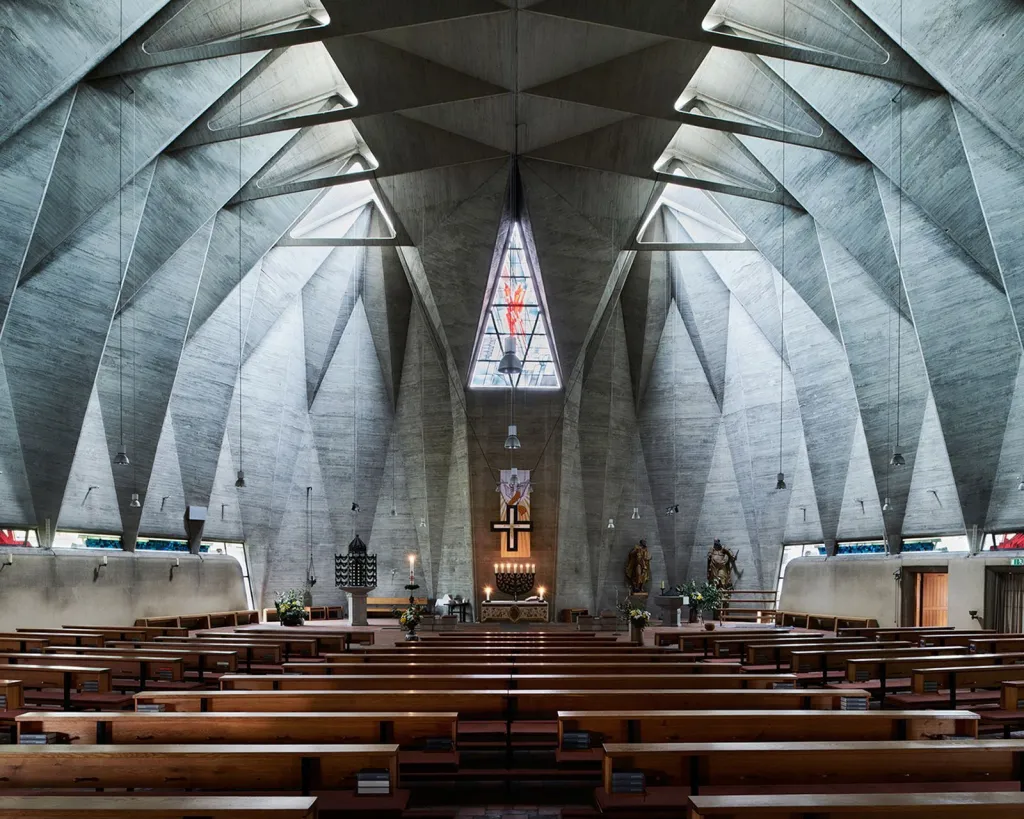In a Europe defined by Gothic cathedrals and Renaissance churches—where ornamentation and opulence are synonymous with faith sculpted in stone—a new form of religious architecture emerged in the 20th century, breaking with centuries of tradition. These churches, designed in the Brutalist style, are monuments of concrete and minimalism, representing an architectural boldness that challenges conventional notions of visual spirituality.
British photographer Jamie McGregor Smith, who grew up surrounded by the historic and traditional church architecture of the United Kingdom, was profoundly impacted by this new vision of sacred space. In 2018, when he moved with his family to Vienna, Austria, he encountered an architectural reality that was previously unfamiliar to him: cathedrals and churches that, instead of pointed arches and intricate rose windows, featured straight lines, exposed concrete surfaces, and an aesthetic that evoked fortresses rather than temples.

Driven by growing curiosity, McGregor Smith embarked on a journey across Europe to document these modern and, in many ways, controversial structures. He was not content with mere observation—he sought to capture the essence of these buildings, which, despite their cold and austere appearance, carried a unique spiritual energy. To achieve this, he meticulously planned a series of train journeys that would take him to some of the continent’s most unexpected corners.
Over four years, McGregor Smith traveled through eight countries, photographing nearly 200 churches, all conceived and built between the 1960s and 1970s. These decades, marked by profound social and political transformations, also witnessed a radical shift in the way religious spaces were designed. Brutalist churches, with their geometric forms and raw materials, seemed to offer a new language for faith—one that relied not on ornamentation but on the purity of form and the strength of materials.
McGregor Smith’s work is not just a photographic record; it is an exploration of how architecture can challenge and redefine our perceptions of spirituality and community. Through his photography, he invites the viewer to reconsider what the sacred means in a world that continues to evolve, both in form and function.
The result of this photographic journey is the book Sacred Modernity: The Holy Embrace of Modernist Architecture, featuring an impressive collection of 139 photographs of these unique buildings. This work not only documents the Brutalist architecture of European churches but also celebrates the fusion of sculpture, engineering, and architectural design with a profound spiritual purpose.
Among the churches highlighted in the book is the Templo Mariano di Monte Grisa in Trieste, Italy. Completed in 1965, the temple is notable for its triangular concrete motifs, giving the building an almost sculptural presence. In Cologne, Germany, the Christi Auferstehung Kirche, finished in 1970, is famous for its cavernous and minimalist interiors, creating a space of introspection and reverence. Meanwhile, in Graz, Austria, the Mehrzweckhalle der Schulschwestern, completed in 1979, offers aerial views of a structure resembling an accordion, demonstrating the flexibility and innovation in religious space design.
Although traditional church institutions may not seem like the most natural partners for modernist architecture, the post-World War II social and historical context played a crucial role in the emergence of this innovative architectural style. The war’s devastating impact and the subsequent need for reconstruction and renewal deeply influenced how religious architecture evolved.
During the Second Vatican Council, held between 1962 and 1965 in Vatican City, bishops from across the Catholic world gathered to discuss how the Church could adapt to a rapidly changing world. Among the many topics addressed, church architectural design was a significant focus. The desire to modernize and reflect a more optimistic future led to the search for new architectural expressions.
“Both Catholic and Protestant churches wanted to project a brighter and more optimistic future,” explains McGregor Smith. “After the trauma of war, many young priests were eager to collaborate with the most innovative and visionary modernist architects.”
This collaboration resulted in a series of buildings that share common characteristics, as McGregor Smith highlights in his accompanying text. Many of the churches he documented were built with concrete, a material that, besides being economical, provided architects with a new tool for experimentation and pioneering designs.
“Concrete allowed architects to explore forms and structures that were previously unthinkable. It enabled the creation of spaces that break away from conventional architectural norms and traditional design, offering a new aesthetic and functional reality,” observes McGregor Smith.
These architectural innovations not only redefined the appearance of churches but also expressed a new vision of spirituality and the role of sacred spaces, reflecting a desire for renewal and hope in a world deeply scarred by destruction.
Smith references apophatic architecture, an approach suggesting that divine greatness cannot be fully captured through human language or traditional concepts. Instead, it is up to the architect to use visual language and design to attempt to represent the indescribable. In practice, this manifests through elements such as the use of negative space, the interplay of light and shadow, and the creation of an atmosphere of omniscience and transcendence within the spaces designed.
The design of these churches often explores these ideas in innovative ways. Negative space, for instance, is used to create a sense of vastness and mystery, challenging visitors’ perceptions and expectations. The manipulation of light and shadows within the buildings adds layers of depth and complexity, creating an environment that can evoke spirituality and introspection.
As a photographer, McGregor Smith faces a similar challenge in trying to capture the essence of these structures in his images. “Everyone, in some way, is trying to express the inexpressible, or to capture a glimpse of something beautiful and powerful that ordinary words cannot,” he notes. His work is an attempt to visually translate the transcendent experience these churches offer, revealing the depth and complexity of the spaces he documents and allowing the viewer to experience a fragment of the grandeur and innovation these buildings represent.
For McGregor Smith, these churches are a microcosm of the past, present, and future of religious institutions. “These spaces offer an opportunity to engage society in new ways—whether through religion, design, or social interactions,” he explains. They represent a bridge between architectural innovation and spiritual experience, offering a vision of how religion and design can intertwine to create new forms of connection.
However, just as the emergence of modernist churches in the postwar era required adaptation and innovation, the present reality also demands continuous evolution. “Religion, by nature, is conscious of trends. The Church must always stay current; otherwise, parishioners will abandon it,” observes McGregor Smith. The ability to adapt and innovate remains crucial for the relevance of religious institutions in an ever-changing world.

